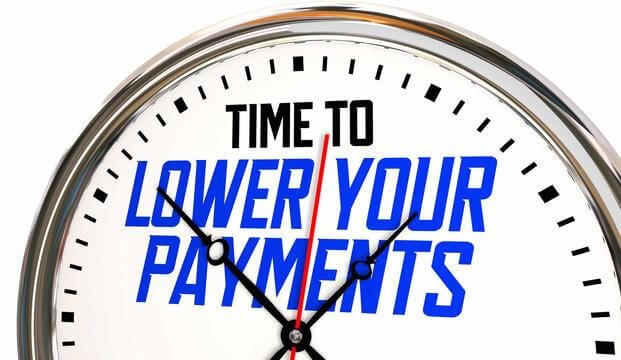Reducing Your Mortgage with an IRRRL
Homes are expensive, and paying off loans can take a great deal of time and money. That's why veterans thinking of refinancing their houses, or who just want better interest rates, should look into an Interest Rate Reduction Refinance Loan (IRRRL).
These loans can reduce the interest rate when a VA home loan is refinanced. They can be a good option for veterans and military families looking to refinance their existing VA loans while experiencing less paperwork and a faster closing.
An IRRRL is an option only for real estate originally purchased with a VA loan, but they're relatively easy to acquire.
If you have an adjustable rate mortgage, you may opt for a fixed mortgage rate when applying for the IRRRL, also called the VA Streamline Refinance.
There's no appraisal, credit underwriting or certificate of eligibility requirement, and you don't need to use any money out of pocket.
Your loan officer can spell out all the paperwork and help you decide whether a streamline refinance is right for your situation. If your streamline loan rate is not 1%-2% lower than your existing VA loan, it might not be worth changing loans.
Related: IRRRL Facts for Veterans
Who Is Eligible for a VA IRRRL?
The IRRRL program is available only to those who have already used the eligibility for a VA loan on the properties they intend to refinance.
The occupancy requirement for an IRRRL is different from other VA loans. When you originally got your VA loan, you certified that you occupied or intended to occupy the home. For an IRRRL, you need only certify that you previously occupied it. This verification is relatively easy to provide, and can be evidenced by providing a copy of the original settlement statement or initial VA loan document.
The veteran, including active-duty service members stationed elsewhere, is able to satisfy the occupancy requirement by certifying prior occupancy.
If the veteran whose entitlement was previously used has died, and the surviving spouse was a co-obligor, that spouse is considered a veteran for the purpose of the IRRRL.
Qualifying for an IRRRL
To be eligible, you need to be up to date on your VA mortgage payments.
The Department of Veterans Affairs officially defines this rule by saying the due date of the first monthly payment of the VA loan you are refinancing must be 210 days or more prior to the closing date of your new loan refinance. This works out to roughly six months for many borrowers. You also need to have made six consecutive monthly payments on the VA loan you are refinancing.
Verification of income for all borrowers on the VA streamline is not required. That means, unlike the original VA loan when paycheck stubs, W-2 forms and tax returns were provided, the IRRRL requires no income verification whatsoever. This is assuming the existing mortgage has been paid as agreed for the last 12 months and is up to date.
There is no minimum credit score required for a VA streamline loan. The lender, however, will verify that there are no payments in the last 12 months that were more than 30 days past the due date. A lender can pull a credit report for this verification but does not consider credit scores.
Your lender should be able to help determine your entitlement usage. If not, you can request a COE by mail by filling out a Request for a Certificate of Eligibility (VA Form 26-1880) and mailing it to the address for your regional loan center. You can find the address on the last page of the form. Mail requests may take longer than requesting a COE through your lender.
Related: VA Home Loan Streamline Refinance FAQ
How to Get an IRRRL
To qualify for an IRRRL, the new loan must be at a lesser interest rate than the old VA loan except when refinancing an existing adjustable rate mortgage with a new fixed-rate mortgage. The dollar amount of guaranty applicable to the prior VA loan is transferred to the new loan. The minimum guaranty on an IRRRL is 25%.
If the existing loan is delinquent, the IRRRL must be submitted to the VA for prior approval.
Finding a Lender
Not happy with your current lender? No lender is required to make you an IRRRL, but any lender of your choice may process your application for an IRRRL. While your current lender might be the best place to start shopping for an IRRRL, you do not have to go to the lender you make your payments to now or to the lender from whom you originally obtained your VA loan.
Homeowners are strongly urged to contact several lenders. There may be big differences in the terms offered by the various lenders you contact.
Some lenders may contact you, suggesting they are the only lender with authority to make IRRRLs. Remember: Any lender may make you an IRRRL.
Some lenders may say the VA requires certain closing costs to be charged and included in the loan. Remember: The only cost required by the VA is a funding fee of one-half of 1% of the loan amount, which may be paid in cash or included in the loan.
With that being said, lenders may also impose their own internal lending guidelines. As long as the lender employs the guideline across the board and does not selectively apply the additional rule to a particular borrower, which could be an indication of discrimination, a lender has the right to add other qualifications. These additional qualifications are called "overlays."
"If you have a VA home loan, be careful when considering home loan refinance offers," the VA warns. "Claims that you can skip payments or get very low interest rates or other terms that sound too good to be true may be signs of a misleading offer."
Related: Is Refinancing Worth Your While?
Provide the Needed Information for an IRRRL
Since you needed to provide a certificate of eligibility (COE) for your original VA loan, you won't need to provide it again for your refinance. Your lender can use the VA's email confirmation procedure for interest rate reduction refinance in lieu of a COE. In other words, the new loan "piggybacks" on the existing eligibility.
A veteran who refinances must, however, sign a statement "acknowledging the effect of the refinancing loan on the veteran's loan payments and interest rate," the VA says.
The statement must show a comparison of the new vs. the old loan, i.e. the interest rate and monthly payments for both. It also must state how long it would take to recoup all closing costs.
If the monthly payment is going to be 20% or higher when compared with the existing loan, the paperwork that the lender submits has to include a certification that the veteran qualifies for the new monthly amount.
Related: Forms Needed for IRRRL Submission
Closing on Your IRRRL
IRRRL closing costs vary from lender to lender. You may have to pay "discount points" to get a certain interest rate. (One point is equal to 1% of the loan amount.) You may have to pay origination fees, which are also called "lender" fees.
Additionally, there can be government recording fees, a funding fee and other costs. The VA allows you to add many closing costs to your loan balance, including up to two discount points and the VA funding fee.
Your loan disclosure documents will explain what closing costs are required and how much you will need to pay. Make sure you understand these costs and ask your lender when you have questions.
"Although VA does not require an appraisal or credit underwriting on IRRRLs, any customary and reasonable credit report or appraisal expense incurred by a lender to satisfy its lending requirements may be charged to the borrower and included in the loan," according to the VA.
Related: VA Streamline Refinance Offers: A Personal Experience
Using an IRRRL
Refinancing must make financial sense. Except when refinancing an existing VA guaranteed adjustable rate mortgage (ARM) to a fixed rate, the refinance must result in a lower interest rate. The VA calls this having a "net tangible benefit." For many loans, you can meet this rule if you reduce your interest rate by at least 0.5%. Lowering your monthly payment or switching to a fixed-rate mortgage can also qualify.
You must have a VA loan. To be eligible for streamline refinancing, you need to replace an existing VA loan with a new VA loan.
Be current on your payments. To be eligible, you need to be up to date on your VA mortgage payments.
Have the VA loan for six months. VA rules officially define this eligibility requirement by saying the due date of the first monthly payment of the VA loan you are refinancing must be 210 days or more prior to the closing date of your new loan refinance. This works out to roughly six months for many borrowers. You also need to have made six consecutive monthly payments on the VA loan you are refinancing.
Take no cash out. You can't borrow money from your home equity with VA IRRRLs. Also, no portion of the loan proceeds may be used to pay off other debts.
Bankruptcy exception. Although no underwriting is required for an IRRRL, approval of new credit may be required by the trustee in a Chapter 13 bankruptcy.
New loan limit. The new loan is limited to the balance of the old loan; the funding fee; up to $6,000 of energy efficient improvements; and allowable closing costs, including no more than two discount points.
Loan term limit. The term of an IRRRL may not exceed the original term of the loan being refinanced by more than 10 years.
How Do I Get Started?
As with most big financial decisions, the first step is gathering information and shopping around. We'll help you get the process started by matching you with up to five rates from five lenders, ensuring you find a great fit.
For more on the IRRRL process, visit the Military.com Refinance section.
Take the Next Step
If you're ready to move forward, or just want more information, the first step is to get no-obligation rate quotes.










